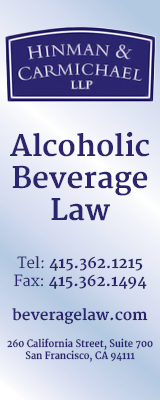FREE! Subscribe to News Fetch, THE daily wine industry briefing - Click Here
![Banner_Xpur_160x600---Wine-Industry-Insight[63]](/wp-content/uploads/Banner_Xpur_160x600-Wine-Industry-Insight63.jpg) |
 ALSO SPONSORED BY: 
Wine Industry Insight |
 |
Gallo Glass Toxics Lawsuit: Biggest Story Involves Unanswered Questions
This is a case of the:
- Dog that didn’t bark.
- Cat that failed to meow.
- Bird that did not squawk. And,
- News media that did not follow-up on logical questions left dangling..
The state of California’s hazardous waste lawsuit against Gallo Glass (.PDF) has raised so many unanswered questions that even Sherlock or Benedict Cumberbatch would fail — at this stage of events — to pull a neat conclusion from the ambiguities.
The lawsuit was filed February 27 by the California Department of Justice (DOJ) on behalf of the state Department of Toxic Substances Control (DTSC). The complaint alleges 15 counts of illegal conduct regarding hazardous wastes and toxic substances.
Wine Industry Insight has prepared a keyword-searchable copy of the complaint which is available at this link for premium Wine Executive News Subscribers.
What The Lawsuit Is Not
First of all, the lawsuit as filed does not — as so many mainstream media headlines screamed — allege a consumer health issue regarding toxic wine bottles containing lead, arsenic, and other heavy metals. (Gallo Glass sued by state for use of hazardous materials in wine bottles)
Gallo representative Natalie Henderson emailed Wine Industry Insight a copy of their statement on the issue (.DOCX) and added: “I want to be very clear – this is a legal issue and not a health issue. Despite the over-the-top title in the State’s press release, the State makes it crystal clear that there is no threat from the bottles. To suggest that this is a safety concern is irresponsible,” Henderson said, “and risks the future of the entire California wine industry.”
The DTSC’s news release is available here with the headline, “DTSC Cites Gallo Glass Company for Using Hazardous Waste in Wine Bottles.” The news release states that “DTSC has no evidence that consuming wine stored in these bottles poses a health threat.”
However, specific scientific tests might change that assessment. WII has asked the state about those tests, but the answers are still pending.
What The Lawsuit Is
It’s safe to say that the lawsuit is primarily a legal conflict for now. That’s because both the complaint and the Gallo statement make it clear that it was filed by the state because the statute of limitations was looming after five years of failing to reach a negotiated settlement. DTSC says it still hopes to negotiate a settlement short of litigation.
As in most disputes, opposing sides see things in stark contrasts.
“This lawsuit has no merit,” said the Gallo statement. ” The Gallo Glass plant is a state-of-the-art facility recognized around the world for its advanced pollution control technologies and environmentally-sustainable practices which the State is inexplicably challenging in this lawsuit.”
The DOJ’s 27-page complaint, on the other hand, disagrees and lays out a list of what it says are Gallo Glass violations that include:
- Improper operation of a facility used to treat recycled lubricating oil used to fuel the glass-making furnaces.
- Mixing tons of waste from furnace exhaust gas into mixtures used to produce glass bottles. The complaint refers to the waste as “sludge” containing lead, arsenic, cadmium and selenium. The complaint says the waste was captured by air pollution devices known as electrostatic precipitators (EP) used to reduce pollutants from the smokestacks.
- Moving and storing EP sludge in on-site silos.
- Disposing EP sludge into landfills not approved for hazardous waste.
- Allowing EP sludge to collect on the ground, walls of the facility and on the facility grounds.
- Disposing of used oil into a sewer and a facility not approved for hazardous waste.
- Disposing of a used oil and oily EP sludge mixture at a facility not approved for hazardous waste.
- Storing hazardous waste without a permit.
- Storing hazardous waste in unapproved tanks, containers and areas.
- Treating used oil without a permit.
- Failure to document the structural integrity of used oil storage tanks and containers
- Failure to properly label used oil storage tanks and containers
- Failure to prevent release of hazardous waste into the environment
- Failure to adequately train personnel in hazardous materials handling and emergencies.
- Failure to provide secondary containment for hazardous waste and used oil.
- Failure to report multiple fires and explosions at the plant
Questions And More Questions
A close look at the charges raised by the DOJ raise a score of questions. Wine Industry Insight selected 4 of the most burning to look close at.
Wine Executive News subscribers please click here to read the complete 1,418-word article.
Also In This Article:
The full text of the following sections is available to premium subscribers of Wine Executive News.
-
Burning Oil. For Fuel? Disposal? Both?
-
Oil: Where Does It Come From? What’s It Used For?
-
Lead, Arsenic, Other Heavy Metals From Oil?
-
No Scientific Certainty Whether Bottles Are Hazardous or Harmless.
Not a Wine Executive News subscriber?
Subscribe to Wine Executive News now, and get the rest of this original article along with everything else on the site every day, including original documents, spreadsheets,and source materials for just $24.99 per month or $189 per year.




